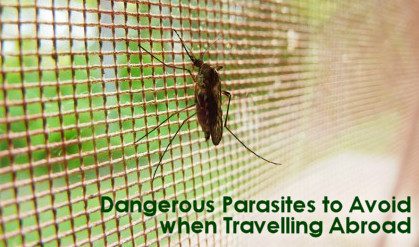Dangerous Parasites to Avoid when Travelling Abroad
Travelling abroad most often involves unusual circumstances. Sleeping at hotels, eating strange food, and meeting new faces can be psychologically unsettling. If you are on a business trip, you are compressed on time and have much to accomplish. And when vacationing, you want to relax and refresh, and return to work in a better mental and physical state. The last thing you want on earth is a pesky little parasite ruining your trip, to say the least.

Some of the parasites on this list are unusual, and some are interesting in a twisted way. Frightening might be more appropriate a word to describe these exotic parasites. Actually, some of these might be creepy enough to make you think about cancelling your travel plans to certain parts of the world. However, you can avoid playing host to these unwanted guests by taking a few simple precautions.
-
Diarrhoea
Travellers’ Diarrhoea is the most common disease among travellers, of course; but it can have some unusual variations. It is commonly caused by E-Coli bacteria, a worm found in soil, water and milk. The bacterium is toxic to the intestine and causes symptoms such as stomach cramps, nausea and vomiting besides explosive diarrhoea. Latin American countries have the highest incidence of E-Coli infection, but countries such as Morocco, India, Thailand, and some other Asian and African countries are host to various strains of diarrhoeal bacteria and amoeba that produce more serious and diverse symptoms and can even be life-threatening. A certain type of amoeba found in faeces can cause blood in stool, for instance, and lead to chronic diseases like irritable bowel syndrome. Whatever the type of parasite, diarrhoea can be seriously debilitating. Fortunately, it can be prevented if you wash your hands before eating anything, avoid eating raw fruits and vegetable unless you’ve washed them with safe water yourself, avoid eating from food stalls, and take only safe drinking water.
-
Typhoid
Salmonella Typhi, a potentially lethal parasite is responsible for causing typhoid fever in some 12.8 million people in developing country every year. The worm has thousands of strains, some more deadly than the others. It is found in human faeces and contaminates food and water. As developed countries do not have this parasite, people travelling to third-world countries are at a greater risk because they have no immunity against the germ. Typhoid is a life-threatening condition and depletes the body’s strength very fast. The high-grade fever that Salmonella Typhi causes can take a couple of weeks to diagnose and treat, and the after-effects can last for months.
-
African Trypanosomiasis (Sleeping Sickness)
If the two parasites we introduced above didn’t stir your interest, here’s a more unusual and interesting microbe that inhabits the African Savannas. It’s a protozoan (trypanosome) just like the germ causing malaria, but this one is carried by tsetse fly native to the African continent. Once bitten and infected, the victim suffers fever, chills, pain in the limbs, and anaemia. Eventually, the bacteria affect the nervous system and cause the victim to become extremely lethargic and sleepy, a phase that can culminate in death. Just like the other diseases on this list, Trypanosomiasis is also easily treatable if detected in time. Prevention is possible through use of mosquito nets, pest control, and insect repellents.
-
Elephantiasis
The morbid condition occurs because of microscopic, thread-like parasitic worms such as Wuchereria bancrofti, Brugia malayi, and B. timori, all of which are carried by mosquitoes. Once inside the body, the worm penetrates the lymphatic system and infects the lymph nodes, stopping the flow of lymph to various parts of the body and causing them to swell.The disease is most common in Africa and in tropical countries. There’s no know cure for elephantiasis, so prevention is the only option.
-
Naegleria fowleri
Never heard of it? The germ is also known by the less medical name “brain-eating amoeba”. It lives in warm lakes, springs and pools. It enters the victim’s body through the nose and travels to the brain, where it resides and eats until the victim dies. The terrible parasite is common in the tropics, but there have been isolated cases of deaths in the US too. You should be wary when going for a swim in a warm tropical lake that you don’t lose your head – well brain – to this dreadful parasite
Dr Garry J McCLean is a health and safety consultant for The Workplace Depot.
